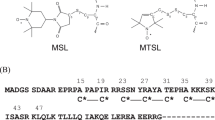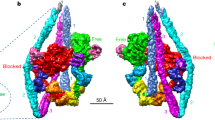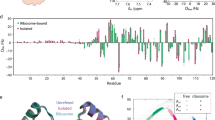Abstract
Electron micrographs showing different cross-bridge orientations in different states of muscle fibres, and X-ray diffraction patterns indicating axial cross-bridge disorder in contracting muscle first suggested that force generation in the contracting muscle involved a change in orientation of the myosin heads that form cross-bridges between thick and thin filaments1,2. This has been supported by subsequent work; the myosin molecule has the required flexibility for changes in orientation3,4. The orientation of muscle tryptophans and of probes attached to the myosin heads of permeable muscle fibres depends on the state of the muscle5–9. Recently, fluorescence polarization fluctuations and time-resolved X-ray diffraction patterns have suggested that cross-bridges of a contracting muscle can rotate10,11. We have used electron paramagnetic resonance (EPR) spectroscopy to monitor the orientation of spin labels attached specifically to a reactive sulphydryl on the myosin heads in glycerinated rabbit psoas skeletal muscle. Previously, it has been shown that the paramagnetic probes are highly ordered in rigor muscle, with a nearly random angular distribution in relaxed muscle12. We show here that during the generation of isometric tension, ∼80% of the probes display a random angular distribution as in relaxed muscle while the remaining 20% are highly oriented at the same angle as found in rigor muscle. These findings indicate that a domain of the myosin head does not change orientation during the power stroke of the contractile interaction.
This is a preview of subscription content, access via your institution
Access options
Subscribe to this journal
Receive 51 print issues and online access
$199.00 per year
only $3.90 per issue
Buy this article
- Purchase on Springer Link
- Instant access to full article PDF
Prices may be subject to local taxes which are calculated during checkout
Similar content being viewed by others
References
Reedy, M. K., Holms, K. C. & Tregear, R. T. Nature 207, 1276–1280 (1965).
Huxley, H. E. Science 114, 1356–1366 (1969).
Mendelson, R. A., Morales, M. F. & Botts, J. Biochemistry 12, 2250–2255 (1973).
Thomas, D. D., Seidel, J. C., Gergely, J. & Hyde, J. S. Proc. natn. Acad. Sci. U.S.A. 72, 1729–1733 (1975).
Aronson, J. F. & Morales, M. F. Biochemistry 8, 4517–4522 (1969).
Dos Remedios, C. G., Millikan, R. G. C. & Morales, M. F. J. gen. Physiol. 59, 103–120 (1972).
Nihei, T., Mendelson, R. A. & Botts, J. Biophys. J. 14, 236–242 (1974).
Borjedo, J. & Putnam, S. Biochim. biophys. Acta 459, 578–595 (1977).
Yanagida, T. J. molec. Biol. 146, 539–560 (1981).
Borjedo, J., Putman, S. & Morales, M. F. Proc. natn. Acad. Sci. U.S.A. 76, 6346–6350 (1979).
Huxley, H. E. et al. Proc. natn. Acad. Sci. U.S.A. 78, 2297–2301 (1981).
Thomas, D. D. & Cooke, R. Biophys. J. 32, 891–906 (1980).
Thomas, D. D., Ishiwata, S., Seidel, J. C. & Gergely, J. Biophys. J. 32, 873–980 (1980).
Thomas, D. D., Barnett, V. A., Wendt, C. H. & Lindahl, K. D. Biophys. J. (submitted).
Barnett, V. A. & Thomas, D. D. J. molec. Biol. (submitted).
Goldman, Y. E. & Simmons, R. M. J. Physiol., Lond. 269, 55P (1977).
Haselgrove, J. & Huxley, H. E. J. molec. Biol. 77, 549–568 (1973).
Curtin, N. A., Gilber, C., Kretzschmar, K. M. & Wilkie, D. R. J. Physiol., Lond. 238, 455–472 (1974).
Arata, T. & Shimizu, H. J. molec. Biol. 151, 411–437 (1981).
Huxley, A. F., Simmons, R. M. Nature 233, 533–538 (1971).
Barden, J. A. & Mason, P. Science 199, 212–213 (1978).
Podolsky, R. J. & Nolan, A. C. Cold Spring Harb. Symp. Quant. Biol. 37, 661–668 (1972).
Eisenberg, E., Hill, T. L. & Chen, Y. Biophys. J. 29, 195–227 (1980).
Cooke, R. Nature 294, 570–571 (1981).
Harrington, W. F. Proc. natn. Acad. Sci. U.S.A. 68, 685–689 (1971).
Author information
Authors and Affiliations
Rights and permissions
About this article
Cite this article
Cooke, R., Crowder, M. & Thomas, D. Orientation of spin labels attached to cross-bridges in contracting muscle fibres. Nature 300, 776–778 (1982). https://doi.org/10.1038/300776a0
Received:
Accepted:
Issue Date:
DOI: https://doi.org/10.1038/300776a0
This article is cited by
-
Structural Dynamics of Protein Interactions Using Site-Directed Spin Labeling of Cysteines to Measure Distances and Rotational Dynamics with EPR Spectroscopy
Applied Magnetic Resonance (2024)
-
Studies on the impellers generating force in muscle
Biophysical Reviews (2020)
-
Direct visualization of human myosin II force generation using DNA origami-based thick filaments
Communications Biology (2019)
-
Stiffness, working stroke, and force of single-myosin molecules in skeletal muscle: elucidation of these mechanical properties via nonlinear elasticity evaluation
Cellular and Molecular Life Sciences (2013)
-
Mesoscopic analysis of motion and conformation of cross-bridges
Biophysical Reviews (2012)
Comments
By submitting a comment you agree to abide by our Terms and Community Guidelines. If you find something abusive or that does not comply with our terms or guidelines please flag it as inappropriate.



